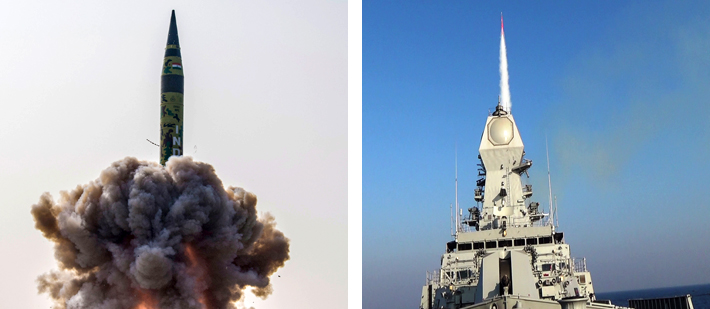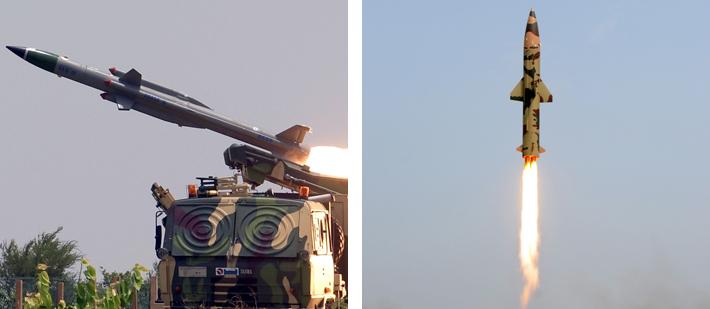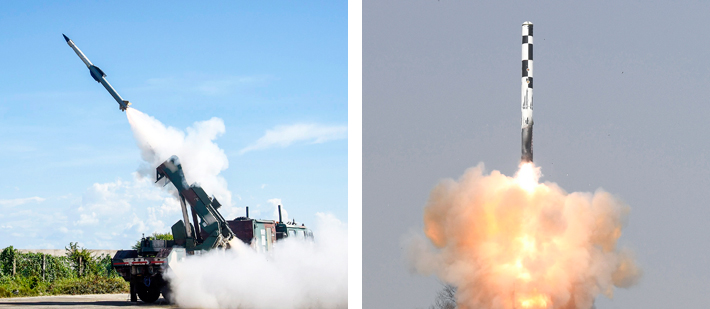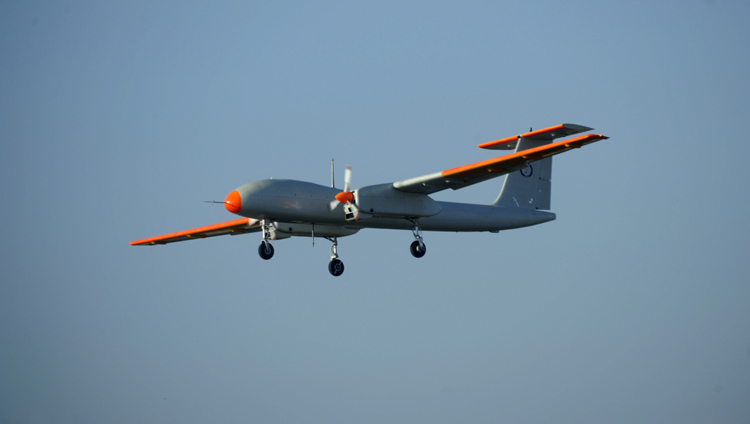INDIAN ARMED FORCES CHIEFS ON OUR RELENTLESS AND FOCUSED PUBLISHING EFFORTS

The insightful articles, inspiring narrations and analytical perspectives presented by the Editorial Team, establish an alluring connect with the reader. My compliments and best wishes to SP Guide Publications.

"Over the past 60 years, the growth of SP Guide Publications has mirrored the rising stature of Indian Navy. Its well-researched and informative magazines on Defence and Aerospace sector have served to shape an educated opinion of our military personnel, policy makers and the public alike. I wish SP's Publication team continued success, fair winds and following seas in all future endeavour!"

Since, its inception in 1964, SP Guide Publications has consistently demonstrated commitment to high-quality journalism in the aerospace and defence sectors, earning a well-deserved reputation as Asia's largest media house in this domain. I wish SP Guide Publications continued success in its pursuit of excellence.
- MoD initiates comprehensive review of Defence Acquisition Procedure 2020, pushes for defence reforms
- G7: The Swansong
- Kalinga Connect: South Asia to Polynesia
- Must Credit DRDO for Operation Sindoor, now what is next for defence R&D?
- The layered Air Defence systems that worked superbly, the key element of Operation Sindoor
- Operation Sindoor | Day 2 DGMOs Briefing
- Operation Sindoor: Resolute yet Restrained
India's Embrace of Counter-War Technologies: Strengthening National Defence
In an era characterised by rapid technological advancements and shifting geopolitical dynamics, India has been significantly enhancing its defence capabilities by adopting advanced counter-war technologies. As modern warfare increasingly involves a spectrum of threats ranging from ballistic missiles to cyber incursions and space-based challenges, India's commitment to integrating cutting-edge defence systems is crucial for maintaining national security and strategic stability.



(Left to Right) - (Top) Agni V, LR SAM; (Middle) Akash, Prithvi; (Above) QR SAM, BrahMos
This article delves into India's advancements in counter-war technologies, compares these with global practices, and explores why these technologies are vital for India's defence strategy, incorporating detailed data and comparisons to provide a comprehensive perspective.
India's focus on developing indigenous counter-war technologies is driven by the need for strategic autonomy and self-reliance, reducing dependence on foreign systems and enhancing national security
Historical Context and Evolution
India's defence technology journey began with a focus on traditional military systems, heavily relying on imports. However, the landscape shifted dramatically after the 1998 nuclear tests and heightened regional tensions. This period marked the onset of a strategic pivot towards self-reliance in defence technology. Notable milestones include the development of the Prithvi missile in the 1980s and the establishment of the Defence Research and Development Organisation (DRDO) in 1983, which has since been instrumental in advancing India's defence capabilities.
Missile Defence Milestones:
- 1990s: Development of the Prithvi and Agni missile systems.
- 2000s: Introduction of the AAD and PAD systems as part of India's missile defence initiative.
- 2010s: Successful interception tests and deployment of the Advanced Medium-Range Air-to-Air Missile (AMRAAM).
Why Counter-War Technologies Are Required for India
India, with its strategic location and complex geopolitical environment, faces a range of security challenges that necessitate the adoption and development of counter-war technologies. These technologies are essential for addressing the multifaceted nature of modern threats and ensuring the country's national security and strategic stability. Here's a detailed exploration of why counter-war technologies are crucial for India:
Complex Geopolitical Landscape
India's geopolitical environment is characterised by both traditional and non-traditional security threats. With ongoing tensions with neighbouring countries such as Pakistan and China, India faces potential threats ranging from conventional military conflicts to asymmetric warfare. Counter-war technologies like advanced missile defence systems and surveillance platforms are crucial for detecting, neutralising, and mitigating these threats. For instance, India's development of the Advanced Air Defence (AAD) and Prithvi Air Defence (PAD) systems is a direct response to potential missile threats from neighbouring adversaries.
The establishment of the National Cyber Security Coordination Centre (NCSC) reflects India's commitment to strengthening its cyber defences amid a 30 per cent increase in reported cyber incidents
Strategic Autonomy and Self-Reliance
India's focus on developing indigenous counter-war technologies is driven by the need for strategic autonomy and self-reliance. By investing in homegrown defence technologies, India aims to reduce its dependence on foreign systems and ensure that its defence capabilities are tailored to its specific needs. This approach enhances national security by ensuring that critical technologies are under national control and can be quickly adapted to evolving threats. The successful deployment of systems like the AAD and PAD demonstrates India's commitment to achieving self-reliance in defence.
Cybersecurity Threats
With the increasing reliance on digital infrastructure, cybersecurity has become a critical component of national defence. India has witnessed a surge in cyber-attacks, with a 30 per cent increase in reported incidents over the past year (Source: National Cyber Security Coordination Centre, 2023). The establishment of the National Cyber Security Coordination Centre (NCSC) reflects India's commitment to strengthening its cyber defences. Advanced cybersecurity technologies are essential for protecting critical infrastructure, safeguarding sensitive information, and maintaining the integrity of digital systems.
India's advancements in missile defence, including the Advanced Air Defence (AAD) and Prithvi Air Defence (PAD) systems, demonstrate a significant stride in protecting against potential missile threats
Maritime Security
India's strategic interests are closely tied to its maritime domain, with crucial sea lanes and territorial waters that require robust protection. The Indian Navy's investment in advanced underwater surveillance systems and anti-submarine warfare (ASW) technologies is vital for securing maritime borders and addressing underwater threats. The development of sophisticated sonar systems and indigenous ASW technologies enhances India's ability to monitor and protect its maritime interests.
Space-Based Assets
The integration of space-based technologies into defence strategies is becoming increasingly important. India's space programme, led by the Indian Space Research Organisation (ISRO), includes projects like the GSAT-7A military satellite, which enhances satellite-based surveillance and communication. Space-based assets provide critical data for monitoring and responding to threats, and their protection is essential for maintaining national security. As space becomes a contested domain, ensuring the security of space-based assets is crucial for maintaining strategic advantages.
Adapting to Emerging Technologies
The rapid pace of technological advancements requires continuous adaptation and integration of new counter-war technologies. Innovations such as directed energy weapons, artificial intelligence (AI), and autonomous systems are transforming modern warfare. India's investment in these technologies is essential for staying ahead of potential adversaries and addressing emerging threats. For example, AI and machine learning are used to analyse vast data sets from satellites and UAVs, providing actionable intelligence for strategic decision-making.
The integration of space-based technologies into India's defence strategy, such as the GSAT-7A military satellite, is crucial for enhancing satellite-based surveillance and communication
Countering Asymmetric and Hybrid Threats
Modern conflicts often involve asymmetric and hybrid threats, where adversaries use unconventional tactics and a combination of traditional and non-traditional methods. Counter-war technologies are crucial for addressing these diverse threats, which may include cyber warfare, irregular warfare, and advanced weaponry. India's development of technologies like unmanned aerial vehicles (UAVs) and advanced missile defence systems reflects its commitment to countering asymmetric and hybrid threats effectively.
Counter-war technologies contribute to enhancing operational readiness by improving decision-making processes, automating routine tasks, and performing complex missions in hazardous environments. Technologies such as robotics, autonomous systems, and advanced surveillance platforms reduce human risk and increase the effectiveness of military operations. For example, autonomous drones can conduct reconnaissance missions in hostile territories, providing real-time intelligence without endangering personnel.
Modern conflicts often involve asymmetric and hybrid threats, making counter-war technologies like unmanned aerial vehicles (UAVs) and advanced missile defence systems essential for India's national defence
Maintaining Technological Superiority
In the competitive global defence landscape, maintaining technological superiority is essential for national security. Advanced counter-war technologies provide a strategic advantage by enhancing a nation's ability to detect, intercept, and neutralise threats. India's focus on developing cutting-edge technologies in missile defence, surveillance, and cybersecurity reflects its commitment to maintaining a strategic edge in modern warfare.
Counter-war technologies are crucial for India due to its complex geopolitical environment, the need for strategic autonomy, the growing threat of cyber-attacks, the importance of maritime security, and the integration of space-based assets into national defence. As the global security landscape continues to evolve, ongoing investment in and development of counter-war technologies will be essential for ensuring national security and preserving India's strategic advantages.
Advances in Counter-War Technologies
Missile Defence Systems
India's missile defence capabilities have made significant strides with the deployment of the Advanced Air Defence (AAD) and Prithvi Air Defence (PAD) systems. The AAD system, designed to intercept and destroy incoming ballistic missiles, has achieved a success rate of over 90 per cent in trials conducted by the Defence Research and Development Organisation (DRDO) (Source: DRDO, 2023). Similarly, the PAD system is tailored to intercept intermediate-range ballistic missiles.
Global Comparisons:
- US THAAD: The Terminal High Altitude Area Defense (THAAD) system, developed by the US, boasts an interception success rate of around 80 per cent in operational tests (Source: US Missile Defense Agency, 2023).
- Israel's Iron Dome: This system, designed for short-range missile defence, is renowned for its high interception rate, which exceeds 90 per cent (Source: Israeli Defense Forces, 2023).
| System | Country | Success Rate | Key Features |
|---|---|---|---|
| AAD | India | 90%+ | Ballistic missile interception |
| THAAD | USA | 80% | High-altitude interception |
| Iron Dome | Israel | 90%+ | Short-range missile defence |
Surveillance and Reconnaissance
India's advancements in surveillance and reconnaissance are exemplified by the integration of unmanned aerial vehicles (UAVs) like the DRDO's Rustom-2. Equipped with high-resolution cameras and long endurance, the Rustom-2 enhances India's ability to conduct real-time surveillance and gather intelligence along its borders.

Global Comparisons:
- US MQ-9 Reaper: Known for its high-altitude surveillance and precision strike capabilities, the MQ-9 Reaper is extensively used by the US for reconnaissance and combat missions.
- China's CH-4 Drone: The CH-4 drone, also known for its reconnaissance and strike capabilities, demonstrates China's advancements in UAV technology (Source: China Daily, 2023).
| UAV | Country | Key Features | Endurance |
|---|---|---|---|
| Rustom-2 | India | High-resolution cameras, long endurance | 15-18 hours |
| MQ-9 Reaper | USA | High-altitude, precision strike | 27 hours |
| CH-4 Drone | China | Reconnaissance, strike capabilities | 30 hours |
Cybersecurity
With the increasing frequency of cyber-attacks, India has established the National Cyber Security Coordination Centre (NCSC) to enhance its cybersecurity posture. The NCSC focuses on safeguarding critical infrastructure and responding to a reported 30 per cent increase in cyber incidents over the past year (Source: National Cyber Security Coordination Centre, 2023).

Global Comparisons:
- US CISA: The Cybersecurity and Infrastructure Security Agency (CISA) provides a comprehensive framework for managing cyber threats, emphasising real-time monitoring and threat intelligence.
- EU Cybersecurity Act: This regulation aims to enhance the EU's overall cybersecurity posture, focusing on critical infrastructure protection and incident reporting.
| Agency/Act | Country/Region | Focus | Recent Cyber Incidents |
|---|---|---|---|
| NCSC | India | Critical infrastructure protection | 30% increase in incidents (2023) |
| CISA | USA | Cyber threat management | Increased focus on critical infrastructure |
| Cybersecurity Act | EU | Incident reporting, infrastructure protection | Enhanced regulatory measures |
Maritime Security
The Indian Navy has made significant investments in maritime security, including advanced sonar systems and anti-submarine warfare (ASW) technologies. These systems have contributed to a marked reduction in maritime security incidents.

Global Comparisons:
- US Navy Sonar Systems: The US Navy employs advanced sonar systems for submarine detection and anti-submarine warfare, reflecting its emphasis on maritime security.
- China's Submarine Detection: China has invested in advanced technologies for submarine detection and maritime surveillance, highlighting its growing maritime capabilities.
| System/Technology | Country | Key Features | Impact |
|---|---|---|---|
| Advanced Sonar | India | Submarine detection, ASW | Reduced maritime incidents |
| US Navy Sonar | USA | High-resolution sonar systems | Enhanced submarine detection |
| Submarine Detection | China | Advanced sonar and radar | Improved maritime security |
Space-Based Defence
India's space programme, spearheaded by the Indian Space Research Organisation (ISRO), includes projects such as the GSAT-7A military satellite. This satellite enhances India's ability to conduct satellite-based surveillance and communication (Source: ISRO, 2023).

Global Comparisons:
- US Military Satellites: The US operates a comprehensive network of military satellites for surveillance, communication, and navigation as per the US Space Force.
- China's Space Expansion: China's expanding space program includes advancements in satellite technology for strategic and military purposes.
| Satellite/Program | Country | Key Features | Role |
|---|---|---|---|
| GSAT-7A | India | Military communication, surveillance | Enhances satellite-based defence |
| US Military Satellites | USA | Extensive network, multi-role | Strategic communication and surveillance |
| Space Expansion | China | Advanced satellite technology | Strategic and military purposes |
Modern War Counter Technologies
- Directed Energy Weapons (DEWs): Directed energy weapons, such as lasers and microwave systems, offer precision and rapid response capabilities. The US Department of Defense is developing these technologies for applications including missile defence and counter-drone operations.
- Artificial Intelligence (AI) and Machine Learning: AI and machine learning play a crucial role in modern defence by automating threat detection, enhancing decision-making, and increasing operational efficiency. These technologies analyse vast amounts of data from various sources to provide actionable intelligence.
- Cyber Warfare Capabilities: Modern cyber warfare technologies are essential for defending against and conducting cyber-attacks. These include advanced encryption, intrusion detection systems, and cyber espionage techniques.
- Robotics and Autonomous Systems: Robotics, including autonomous vehicles and drones, perform critical roles in combat and support operations. These systems reduce human risk and enhance operational capabilities in hazardous environments.
Why Counter-War Technologies Are Crucial for India
- Geopolitical Tensions: India's strategic environment, marked by tensions with neighboring countries such as Pakistan and China, necessitates advanced counter-war technologies to maintain deterrence and readiness in potential conflicts.
- Evolving Threats: The nature of modern warfare involves a range of threats, from traditional military engagements to cyber-attacks and space-based challenges. India's technological advancements are essential for effectively addressing these diverse threats.
- Strategic Autonomy: Developing indigenous counter-war technologies enhances India's strategic autonomy, reducing reliance on foreign systems and increasing self-reliance in national defence.
- National Security: Protecting critical infrastructure, maritime borders, and space assets is vital for ensuring national security. Advanced technologies provide the capability to defend against and mitigate various security threats.
Comparative Analysis: India vs. Global Counter-War Technologies
The following matrix illustrates India's position relative to global standards in various counter-war technologies:
| Technology Area | India | Global Leaders |
|---|---|---|
| Missile Defence | AAD, PAD systems with over 90% success rate (DRDO) | US THAAD (80% success), Israel Iron Dome (90%) |
| Surveillance & Reconnaissance | DRDO's Rustom-2 UAV with advanced features (Indian Air Force) | US MQ-9 Reaper, China's CH-4 Drone |
| Cybersecurity | National Cyber Security Coordination Centre, 30% increase in cyber incidents (NCSC) | US CISA, EU Cybersecurity Act |
| Maritime Security | Advanced sonar and ASW technologies (Indian Navy) | US advanced sonar systems, China's submarine detection |
| Space-Based Defence | GSAT-7A military satellite (ISRO) | US extensive military satellite network, China's space expansion |
Conclusion
India's focus on counter-war technologies represents a significant advancement in its national defence strategy. By investing in sophisticated missile defence systems, cutting-edge surveillance and reconnaissance platforms, robust cybersecurity measures, advanced maritime security technologies, and space-based assets, India is enhancing its ability to address modern threats and maintain strategic superiority. The comparative analysis with global practices underscores India's alignment with international standards, showcasing its commitment to addressing the complexities of contemporary warfare. As global security dynamics continue to evolve, India's ongoing investment in these technologies will be crucial for ensuring national security and maintaining a strategic edge in an increasingly complex global landscape.
The above article is authored by Manish Kumar Jha, Consulting & Contributing Editor for SP's Aviation, SP's Land Forces and SP's Naval Forces who writes on national security, military technology, strategic affairs & policies, and Prof. Amit Das, The ICFAI University, Dehradun, Uttarakhand, India.





